Leadership Styles and Models in Today’s Corporate World Report
VerifiedAdded on 2023/06/15
|9
|2453
|98
Report
AI Summary
This report evaluates various leadership styles and models, examining their impact on organisational culture and diversity management, particularly in the context of Next plc. It explores leadership theories such as the Great Man Theory, Relationship Theory, Transactional Theory, and Situational Leadership Theory. The report also analyses different leadership styles, including autocratic, participative, and laissez-faire, and their effects on employee motivation, work culture, and responsibility. Furthermore, it discusses Victor Vroom's expectancy theory and its relevance to employee performance and motivation. The report concludes that effective leadership is crucial for fostering a positive organisational culture, managing diversity, and achieving business goals.
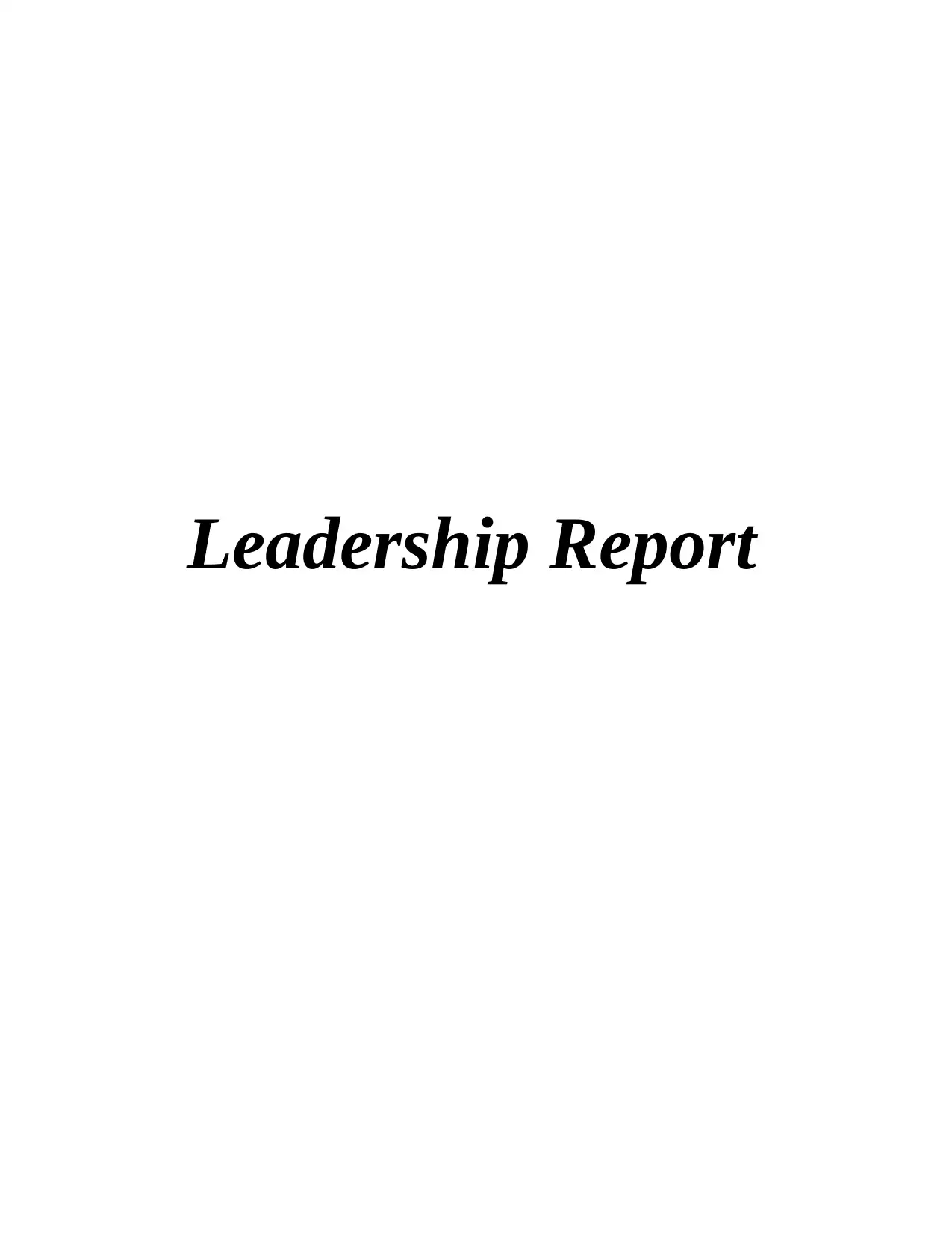
Leadership Report
Paraphrase This Document
Need a fresh take? Get an instant paraphrase of this document with our AI Paraphraser
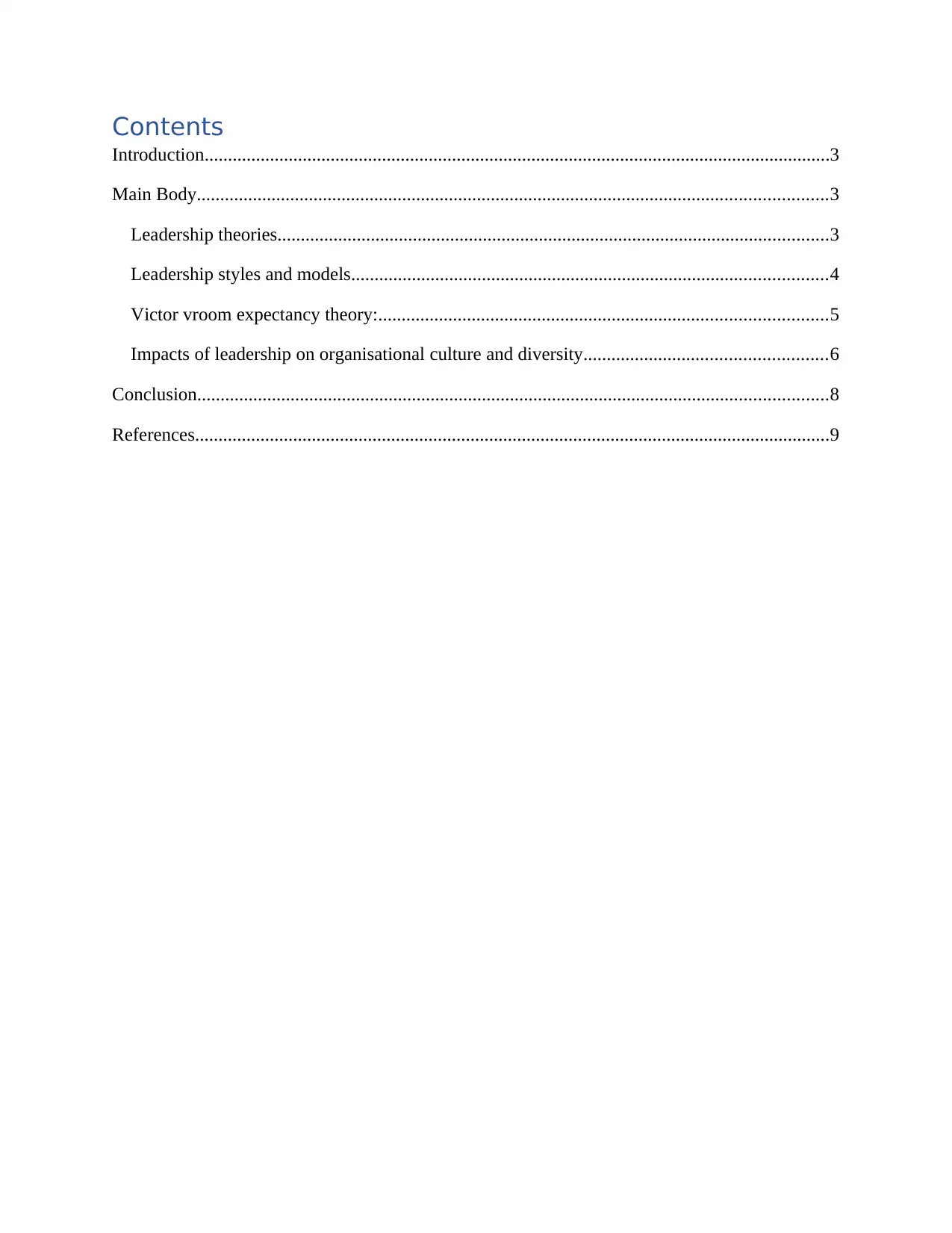
Contents
Introduction......................................................................................................................................3
Main Body.......................................................................................................................................3
Leadership theories......................................................................................................................3
Leadership styles and models......................................................................................................4
Victor vroom expectancy theory:................................................................................................5
Impacts of leadership on organisational culture and diversity....................................................6
Conclusion.......................................................................................................................................8
References........................................................................................................................................9
Introduction......................................................................................................................................3
Main Body.......................................................................................................................................3
Leadership theories......................................................................................................................3
Leadership styles and models......................................................................................................4
Victor vroom expectancy theory:................................................................................................5
Impacts of leadership on organisational culture and diversity....................................................6
Conclusion.......................................................................................................................................8
References........................................................................................................................................9
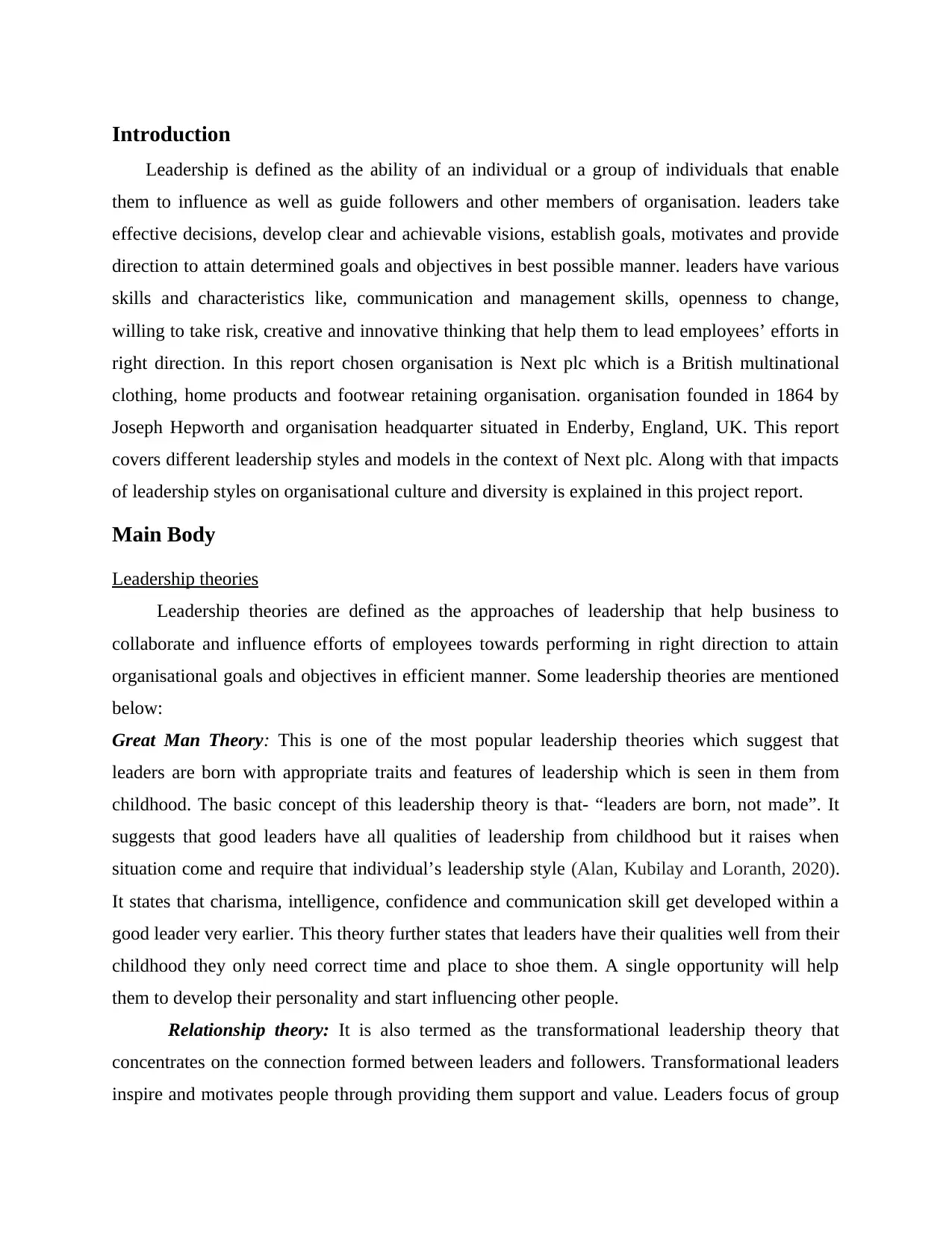
Introduction
Leadership is defined as the ability of an individual or a group of individuals that enable
them to influence as well as guide followers and other members of organisation. leaders take
effective decisions, develop clear and achievable visions, establish goals, motivates and provide
direction to attain determined goals and objectives in best possible manner. leaders have various
skills and characteristics like, communication and management skills, openness to change,
willing to take risk, creative and innovative thinking that help them to lead employees’ efforts in
right direction. In this report chosen organisation is Next plc which is a British multinational
clothing, home products and footwear retaining organisation. organisation founded in 1864 by
Joseph Hepworth and organisation headquarter situated in Enderby, England, UK. This report
covers different leadership styles and models in the context of Next plc. Along with that impacts
of leadership styles on organisational culture and diversity is explained in this project report.
Main Body
Leadership theories
Leadership theories are defined as the approaches of leadership that help business to
collaborate and influence efforts of employees towards performing in right direction to attain
organisational goals and objectives in efficient manner. Some leadership theories are mentioned
below:
Great Man Theory: This is one of the most popular leadership theories which suggest that
leaders are born with appropriate traits and features of leadership which is seen in them from
childhood. The basic concept of this leadership theory is that- “leaders are born, not made”. It
suggests that good leaders have all qualities of leadership from childhood but it raises when
situation come and require that individual’s leadership style (Alan, Kubilay and Loranth, 2020).
It states that charisma, intelligence, confidence and communication skill get developed within a
good leader very earlier. This theory further states that leaders have their qualities well from their
childhood they only need correct time and place to shoe them. A single opportunity will help
them to develop their personality and start influencing other people.
Relationship theory: It is also termed as the transformational leadership theory that
concentrates on the connection formed between leaders and followers. Transformational leaders
inspire and motivates people through providing them support and value. Leaders focus of group
Leadership is defined as the ability of an individual or a group of individuals that enable
them to influence as well as guide followers and other members of organisation. leaders take
effective decisions, develop clear and achievable visions, establish goals, motivates and provide
direction to attain determined goals and objectives in best possible manner. leaders have various
skills and characteristics like, communication and management skills, openness to change,
willing to take risk, creative and innovative thinking that help them to lead employees’ efforts in
right direction. In this report chosen organisation is Next plc which is a British multinational
clothing, home products and footwear retaining organisation. organisation founded in 1864 by
Joseph Hepworth and organisation headquarter situated in Enderby, England, UK. This report
covers different leadership styles and models in the context of Next plc. Along with that impacts
of leadership styles on organisational culture and diversity is explained in this project report.
Main Body
Leadership theories
Leadership theories are defined as the approaches of leadership that help business to
collaborate and influence efforts of employees towards performing in right direction to attain
organisational goals and objectives in efficient manner. Some leadership theories are mentioned
below:
Great Man Theory: This is one of the most popular leadership theories which suggest that
leaders are born with appropriate traits and features of leadership which is seen in them from
childhood. The basic concept of this leadership theory is that- “leaders are born, not made”. It
suggests that good leaders have all qualities of leadership from childhood but it raises when
situation come and require that individual’s leadership style (Alan, Kubilay and Loranth, 2020).
It states that charisma, intelligence, confidence and communication skill get developed within a
good leader very earlier. This theory further states that leaders have their qualities well from their
childhood they only need correct time and place to shoe them. A single opportunity will help
them to develop their personality and start influencing other people.
Relationship theory: It is also termed as the transformational leadership theory that
concentrates on the connection formed between leaders and followers. Transformational leaders
inspire and motivates people through providing them support and value. Leaders focus of group
⊘ This is a preview!⊘
Do you want full access?
Subscribe today to unlock all pages.

Trusted by 1+ million students worldwide
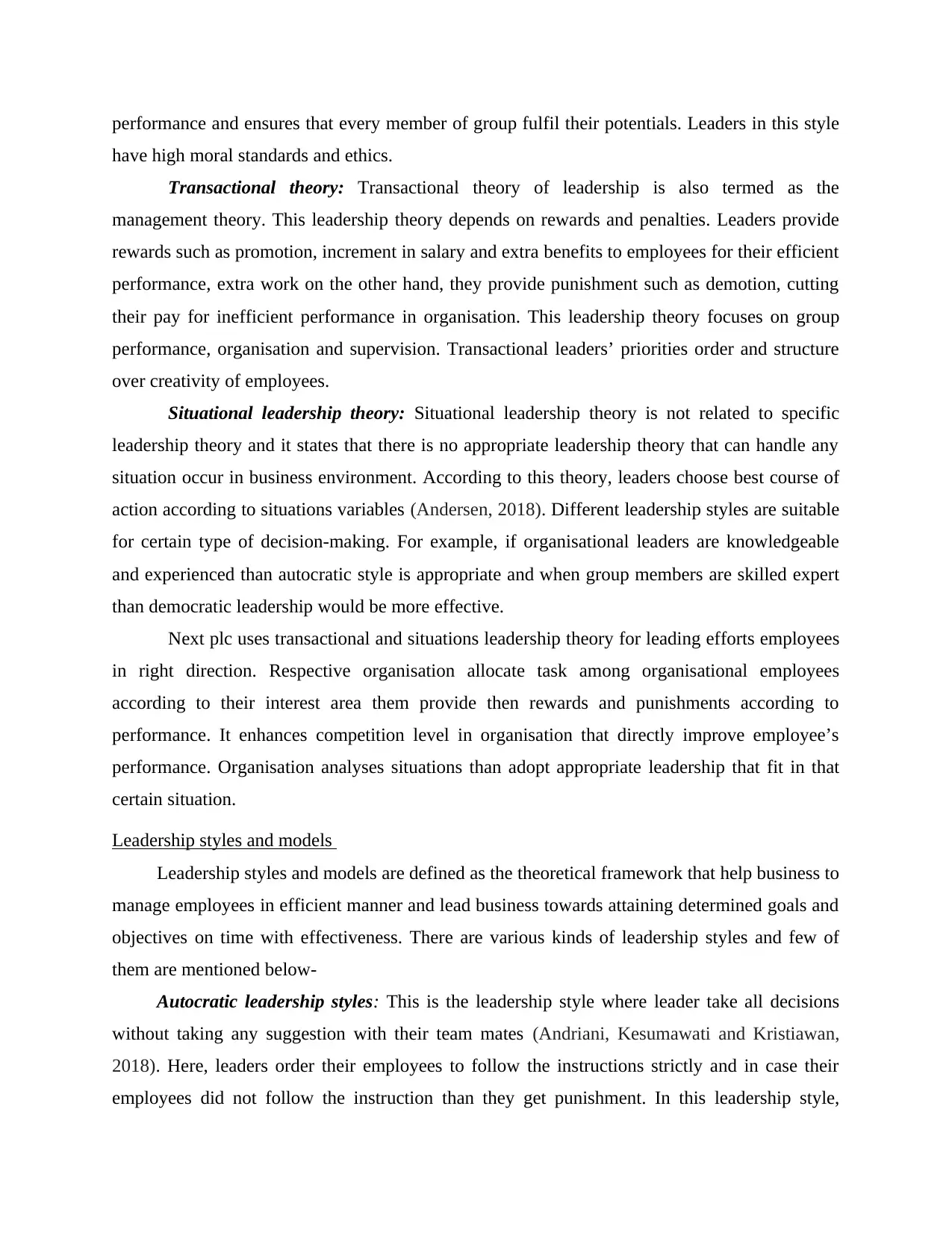
performance and ensures that every member of group fulfil their potentials. Leaders in this style
have high moral standards and ethics.
Transactional theory: Transactional theory of leadership is also termed as the
management theory. This leadership theory depends on rewards and penalties. Leaders provide
rewards such as promotion, increment in salary and extra benefits to employees for their efficient
performance, extra work on the other hand, they provide punishment such as demotion, cutting
their pay for inefficient performance in organisation. This leadership theory focuses on group
performance, organisation and supervision. Transactional leaders’ priorities order and structure
over creativity of employees.
Situational leadership theory: Situational leadership theory is not related to specific
leadership theory and it states that there is no appropriate leadership theory that can handle any
situation occur in business environment. According to this theory, leaders choose best course of
action according to situations variables (Andersen, 2018). Different leadership styles are suitable
for certain type of decision-making. For example, if organisational leaders are knowledgeable
and experienced than autocratic style is appropriate and when group members are skilled expert
than democratic leadership would be more effective.
Next plc uses transactional and situations leadership theory for leading efforts employees
in right direction. Respective organisation allocate task among organisational employees
according to their interest area them provide then rewards and punishments according to
performance. It enhances competition level in organisation that directly improve employee’s
performance. Organisation analyses situations than adopt appropriate leadership that fit in that
certain situation.
Leadership styles and models
Leadership styles and models are defined as the theoretical framework that help business to
manage employees in efficient manner and lead business towards attaining determined goals and
objectives on time with effectiveness. There are various kinds of leadership styles and few of
them are mentioned below-
Autocratic leadership styles: This is the leadership style where leader take all decisions
without taking any suggestion with their team mates (Andriani, Kesumawati and Kristiawan,
2018). Here, leaders order their employees to follow the instructions strictly and in case their
employees did not follow the instruction than they get punishment. In this leadership style,
have high moral standards and ethics.
Transactional theory: Transactional theory of leadership is also termed as the
management theory. This leadership theory depends on rewards and penalties. Leaders provide
rewards such as promotion, increment in salary and extra benefits to employees for their efficient
performance, extra work on the other hand, they provide punishment such as demotion, cutting
their pay for inefficient performance in organisation. This leadership theory focuses on group
performance, organisation and supervision. Transactional leaders’ priorities order and structure
over creativity of employees.
Situational leadership theory: Situational leadership theory is not related to specific
leadership theory and it states that there is no appropriate leadership theory that can handle any
situation occur in business environment. According to this theory, leaders choose best course of
action according to situations variables (Andersen, 2018). Different leadership styles are suitable
for certain type of decision-making. For example, if organisational leaders are knowledgeable
and experienced than autocratic style is appropriate and when group members are skilled expert
than democratic leadership would be more effective.
Next plc uses transactional and situations leadership theory for leading efforts employees
in right direction. Respective organisation allocate task among organisational employees
according to their interest area them provide then rewards and punishments according to
performance. It enhances competition level in organisation that directly improve employee’s
performance. Organisation analyses situations than adopt appropriate leadership that fit in that
certain situation.
Leadership styles and models
Leadership styles and models are defined as the theoretical framework that help business to
manage employees in efficient manner and lead business towards attaining determined goals and
objectives on time with effectiveness. There are various kinds of leadership styles and few of
them are mentioned below-
Autocratic leadership styles: This is the leadership style where leader take all decisions
without taking any suggestion with their team mates (Andriani, Kesumawati and Kristiawan,
2018). Here, leaders order their employees to follow the instructions strictly and in case their
employees did not follow the instruction than they get punishment. In this leadership style,
Paraphrase This Document
Need a fresh take? Get an instant paraphrase of this document with our AI Paraphraser
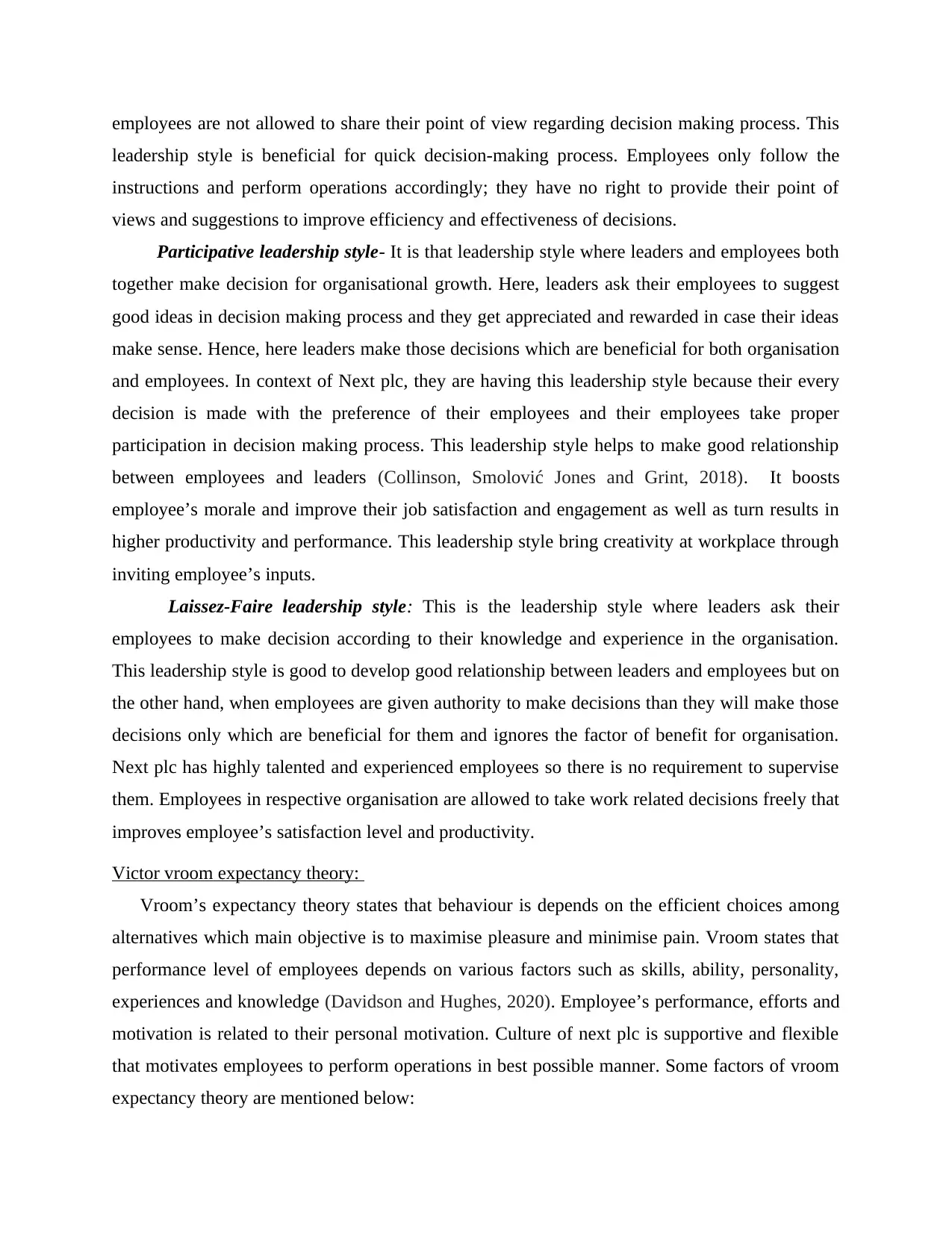
employees are not allowed to share their point of view regarding decision making process. This
leadership style is beneficial for quick decision-making process. Employees only follow the
instructions and perform operations accordingly; they have no right to provide their point of
views and suggestions to improve efficiency and effectiveness of decisions.
Participative leadership style- It is that leadership style where leaders and employees both
together make decision for organisational growth. Here, leaders ask their employees to suggest
good ideas in decision making process and they get appreciated and rewarded in case their ideas
make sense. Hence, here leaders make those decisions which are beneficial for both organisation
and employees. In context of Next plc, they are having this leadership style because their every
decision is made with the preference of their employees and their employees take proper
participation in decision making process. This leadership style helps to make good relationship
between employees and leaders (Collinson, Smolović Jones and Grint, 2018). It boosts
employee’s morale and improve their job satisfaction and engagement as well as turn results in
higher productivity and performance. This leadership style bring creativity at workplace through
inviting employee’s inputs.
Laissez-Faire leadership style: This is the leadership style where leaders ask their
employees to make decision according to their knowledge and experience in the organisation.
This leadership style is good to develop good relationship between leaders and employees but on
the other hand, when employees are given authority to make decisions than they will make those
decisions only which are beneficial for them and ignores the factor of benefit for organisation.
Next plc has highly talented and experienced employees so there is no requirement to supervise
them. Employees in respective organisation are allowed to take work related decisions freely that
improves employee’s satisfaction level and productivity.
Victor vroom expectancy theory:
Vroom’s expectancy theory states that behaviour is depends on the efficient choices among
alternatives which main objective is to maximise pleasure and minimise pain. Vroom states that
performance level of employees depends on various factors such as skills, ability, personality,
experiences and knowledge (Davidson and Hughes, 2020). Employee’s performance, efforts and
motivation is related to their personal motivation. Culture of next plc is supportive and flexible
that motivates employees to perform operations in best possible manner. Some factors of vroom
expectancy theory are mentioned below:
leadership style is beneficial for quick decision-making process. Employees only follow the
instructions and perform operations accordingly; they have no right to provide their point of
views and suggestions to improve efficiency and effectiveness of decisions.
Participative leadership style- It is that leadership style where leaders and employees both
together make decision for organisational growth. Here, leaders ask their employees to suggest
good ideas in decision making process and they get appreciated and rewarded in case their ideas
make sense. Hence, here leaders make those decisions which are beneficial for both organisation
and employees. In context of Next plc, they are having this leadership style because their every
decision is made with the preference of their employees and their employees take proper
participation in decision making process. This leadership style helps to make good relationship
between employees and leaders (Collinson, Smolović Jones and Grint, 2018). It boosts
employee’s morale and improve their job satisfaction and engagement as well as turn results in
higher productivity and performance. This leadership style bring creativity at workplace through
inviting employee’s inputs.
Laissez-Faire leadership style: This is the leadership style where leaders ask their
employees to make decision according to their knowledge and experience in the organisation.
This leadership style is good to develop good relationship between leaders and employees but on
the other hand, when employees are given authority to make decisions than they will make those
decisions only which are beneficial for them and ignores the factor of benefit for organisation.
Next plc has highly talented and experienced employees so there is no requirement to supervise
them. Employees in respective organisation are allowed to take work related decisions freely that
improves employee’s satisfaction level and productivity.
Victor vroom expectancy theory:
Vroom’s expectancy theory states that behaviour is depends on the efficient choices among
alternatives which main objective is to maximise pleasure and minimise pain. Vroom states that
performance level of employees depends on various factors such as skills, ability, personality,
experiences and knowledge (Davidson and Hughes, 2020). Employee’s performance, efforts and
motivation is related to their personal motivation. Culture of next plc is supportive and flexible
that motivates employees to perform operations in best possible manner. Some factors of vroom
expectancy theory are mentioned below:
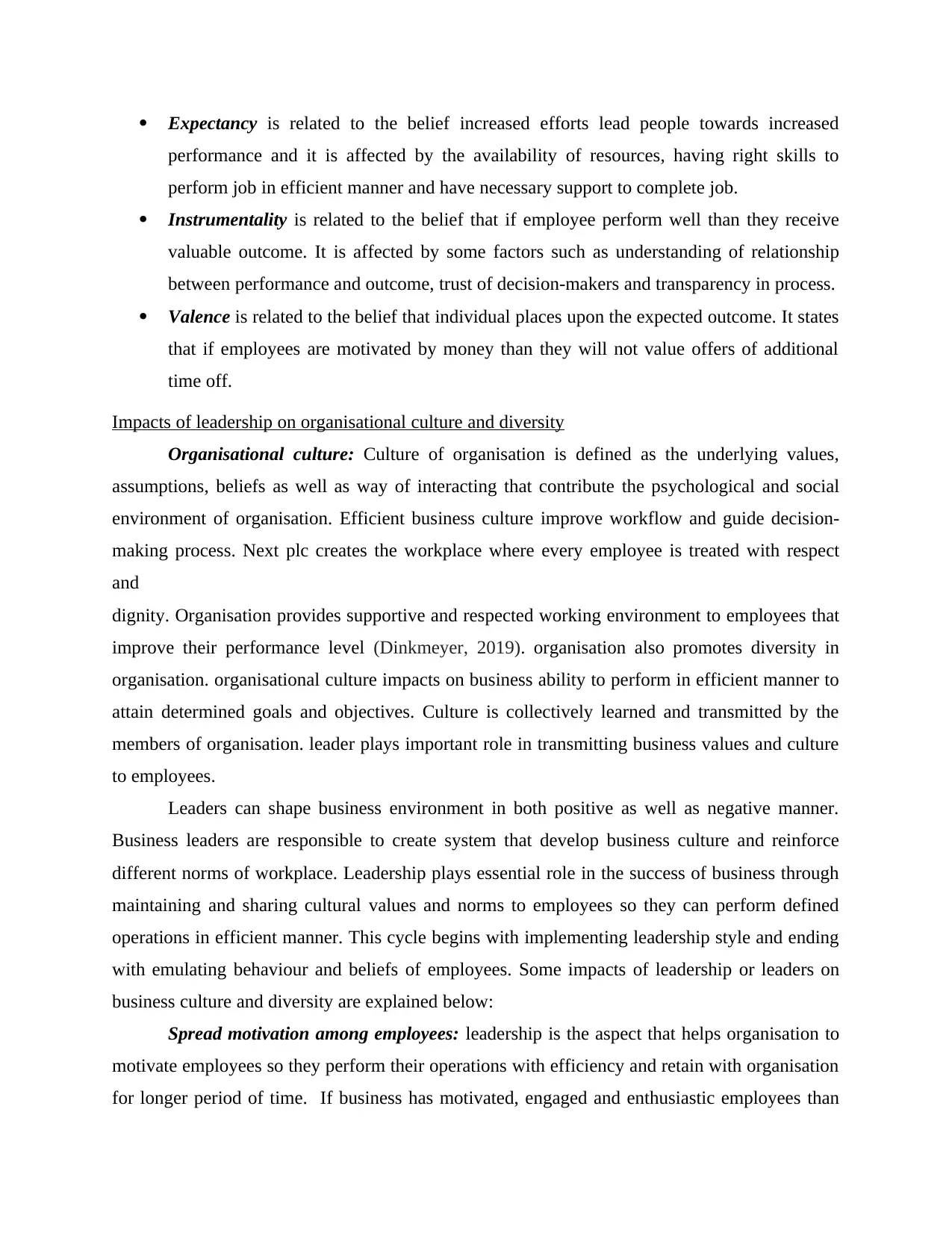
Expectancy is related to the belief increased efforts lead people towards increased
performance and it is affected by the availability of resources, having right skills to
perform job in efficient manner and have necessary support to complete job.
Instrumentality is related to the belief that if employee perform well than they receive
valuable outcome. It is affected by some factors such as understanding of relationship
between performance and outcome, trust of decision-makers and transparency in process.
Valence is related to the belief that individual places upon the expected outcome. It states
that if employees are motivated by money than they will not value offers of additional
time off.
Impacts of leadership on organisational culture and diversity
Organisational culture: Culture of organisation is defined as the underlying values,
assumptions, beliefs as well as way of interacting that contribute the psychological and social
environment of organisation. Efficient business culture improve workflow and guide decision-
making process. Next plc creates the workplace where every employee is treated with respect
and
dignity. Organisation provides supportive and respected working environment to employees that
improve their performance level (Dinkmeyer, 2019). organisation also promotes diversity in
organisation. organisational culture impacts on business ability to perform in efficient manner to
attain determined goals and objectives. Culture is collectively learned and transmitted by the
members of organisation. leader plays important role in transmitting business values and culture
to employees.
Leaders can shape business environment in both positive as well as negative manner.
Business leaders are responsible to create system that develop business culture and reinforce
different norms of workplace. Leadership plays essential role in the success of business through
maintaining and sharing cultural values and norms to employees so they can perform defined
operations in efficient manner. This cycle begins with implementing leadership style and ending
with emulating behaviour and beliefs of employees. Some impacts of leadership or leaders on
business culture and diversity are explained below:
Spread motivation among employees: leadership is the aspect that helps organisation to
motivate employees so they perform their operations with efficiency and retain with organisation
for longer period of time. If business has motivated, engaged and enthusiastic employees than
performance and it is affected by the availability of resources, having right skills to
perform job in efficient manner and have necessary support to complete job.
Instrumentality is related to the belief that if employee perform well than they receive
valuable outcome. It is affected by some factors such as understanding of relationship
between performance and outcome, trust of decision-makers and transparency in process.
Valence is related to the belief that individual places upon the expected outcome. It states
that if employees are motivated by money than they will not value offers of additional
time off.
Impacts of leadership on organisational culture and diversity
Organisational culture: Culture of organisation is defined as the underlying values,
assumptions, beliefs as well as way of interacting that contribute the psychological and social
environment of organisation. Efficient business culture improve workflow and guide decision-
making process. Next plc creates the workplace where every employee is treated with respect
and
dignity. Organisation provides supportive and respected working environment to employees that
improve their performance level (Dinkmeyer, 2019). organisation also promotes diversity in
organisation. organisational culture impacts on business ability to perform in efficient manner to
attain determined goals and objectives. Culture is collectively learned and transmitted by the
members of organisation. leader plays important role in transmitting business values and culture
to employees.
Leaders can shape business environment in both positive as well as negative manner.
Business leaders are responsible to create system that develop business culture and reinforce
different norms of workplace. Leadership plays essential role in the success of business through
maintaining and sharing cultural values and norms to employees so they can perform defined
operations in efficient manner. This cycle begins with implementing leadership style and ending
with emulating behaviour and beliefs of employees. Some impacts of leadership or leaders on
business culture and diversity are explained below:
Spread motivation among employees: leadership is the aspect that helps organisation to
motivate employees so they perform their operations with efficiency and retain with organisation
for longer period of time. If business has motivated, engaged and enthusiastic employees than
⊘ This is a preview!⊘
Do you want full access?
Subscribe today to unlock all pages.

Trusted by 1+ million students worldwide
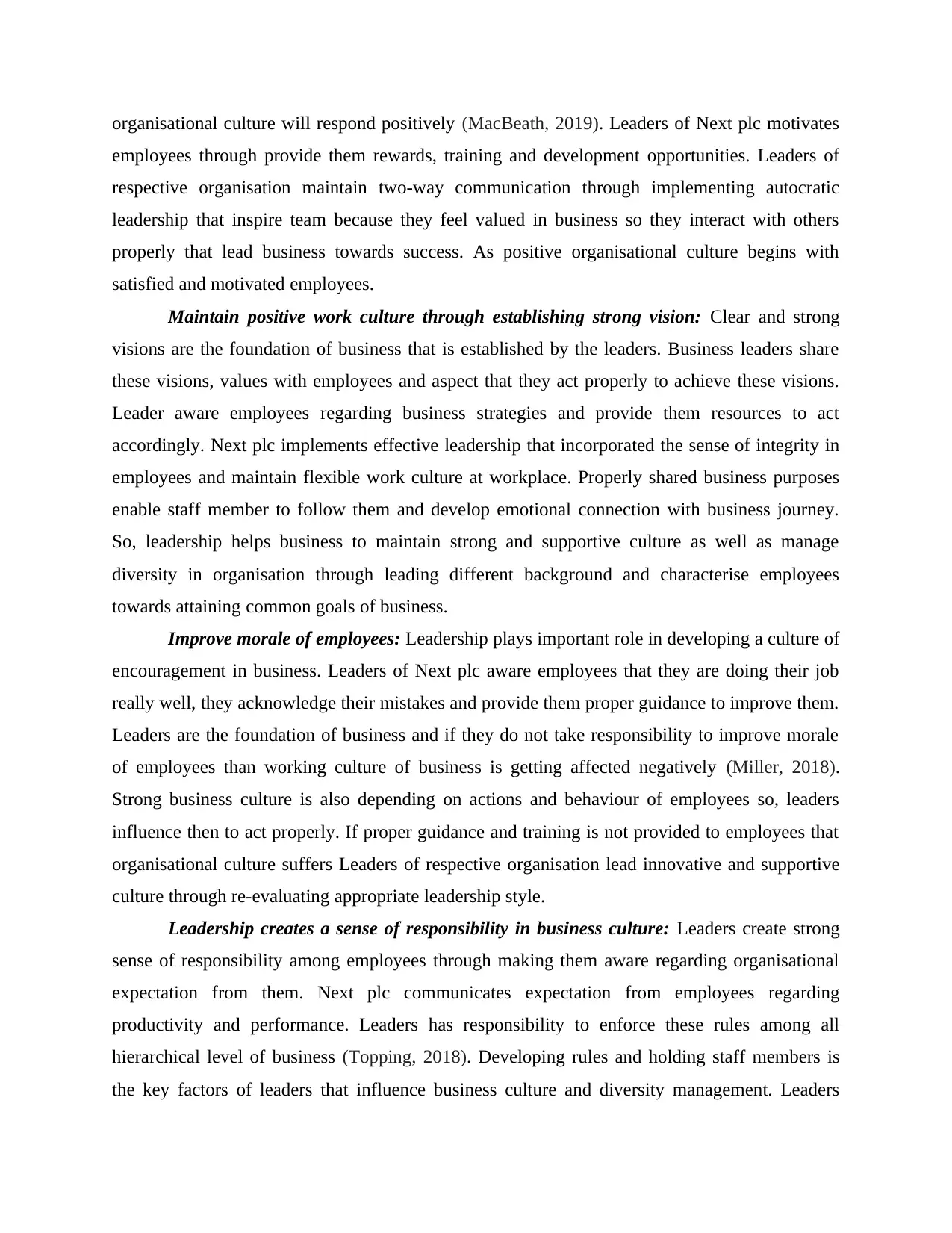
organisational culture will respond positively (MacBeath, 2019). Leaders of Next plc motivates
employees through provide them rewards, training and development opportunities. Leaders of
respective organisation maintain two-way communication through implementing autocratic
leadership that inspire team because they feel valued in business so they interact with others
properly that lead business towards success. As positive organisational culture begins with
satisfied and motivated employees.
Maintain positive work culture through establishing strong vision: Clear and strong
visions are the foundation of business that is established by the leaders. Business leaders share
these visions, values with employees and aspect that they act properly to achieve these visions.
Leader aware employees regarding business strategies and provide them resources to act
accordingly. Next plc implements effective leadership that incorporated the sense of integrity in
employees and maintain flexible work culture at workplace. Properly shared business purposes
enable staff member to follow them and develop emotional connection with business journey.
So, leadership helps business to maintain strong and supportive culture as well as manage
diversity in organisation through leading different background and characterise employees
towards attaining common goals of business.
Improve morale of employees: Leadership plays important role in developing a culture of
encouragement in business. Leaders of Next plc aware employees that they are doing their job
really well, they acknowledge their mistakes and provide them proper guidance to improve them.
Leaders are the foundation of business and if they do not take responsibility to improve morale
of employees than working culture of business is getting affected negatively (Miller, 2018).
Strong business culture is also depending on actions and behaviour of employees so, leaders
influence then to act properly. If proper guidance and training is not provided to employees that
organisational culture suffers Leaders of respective organisation lead innovative and supportive
culture through re-evaluating appropriate leadership style.
Leadership creates a sense of responsibility in business culture: Leaders create strong
sense of responsibility among employees through making them aware regarding organisational
expectation from them. Next plc communicates expectation from employees regarding
productivity and performance. Leaders has responsibility to enforce these rules among all
hierarchical level of business (Topping, 2018). Developing rules and holding staff members is
the key factors of leaders that influence business culture and diversity management. Leaders
employees through provide them rewards, training and development opportunities. Leaders of
respective organisation maintain two-way communication through implementing autocratic
leadership that inspire team because they feel valued in business so they interact with others
properly that lead business towards success. As positive organisational culture begins with
satisfied and motivated employees.
Maintain positive work culture through establishing strong vision: Clear and strong
visions are the foundation of business that is established by the leaders. Business leaders share
these visions, values with employees and aspect that they act properly to achieve these visions.
Leader aware employees regarding business strategies and provide them resources to act
accordingly. Next plc implements effective leadership that incorporated the sense of integrity in
employees and maintain flexible work culture at workplace. Properly shared business purposes
enable staff member to follow them and develop emotional connection with business journey.
So, leadership helps business to maintain strong and supportive culture as well as manage
diversity in organisation through leading different background and characterise employees
towards attaining common goals of business.
Improve morale of employees: Leadership plays important role in developing a culture of
encouragement in business. Leaders of Next plc aware employees that they are doing their job
really well, they acknowledge their mistakes and provide them proper guidance to improve them.
Leaders are the foundation of business and if they do not take responsibility to improve morale
of employees than working culture of business is getting affected negatively (Miller, 2018).
Strong business culture is also depending on actions and behaviour of employees so, leaders
influence then to act properly. If proper guidance and training is not provided to employees that
organisational culture suffers Leaders of respective organisation lead innovative and supportive
culture through re-evaluating appropriate leadership style.
Leadership creates a sense of responsibility in business culture: Leaders create strong
sense of responsibility among employees through making them aware regarding organisational
expectation from them. Next plc communicates expectation from employees regarding
productivity and performance. Leaders has responsibility to enforce these rules among all
hierarchical level of business (Topping, 2018). Developing rules and holding staff members is
the key factors of leaders that influence business culture and diversity management. Leaders
Paraphrase This Document
Need a fresh take? Get an instant paraphrase of this document with our AI Paraphraser
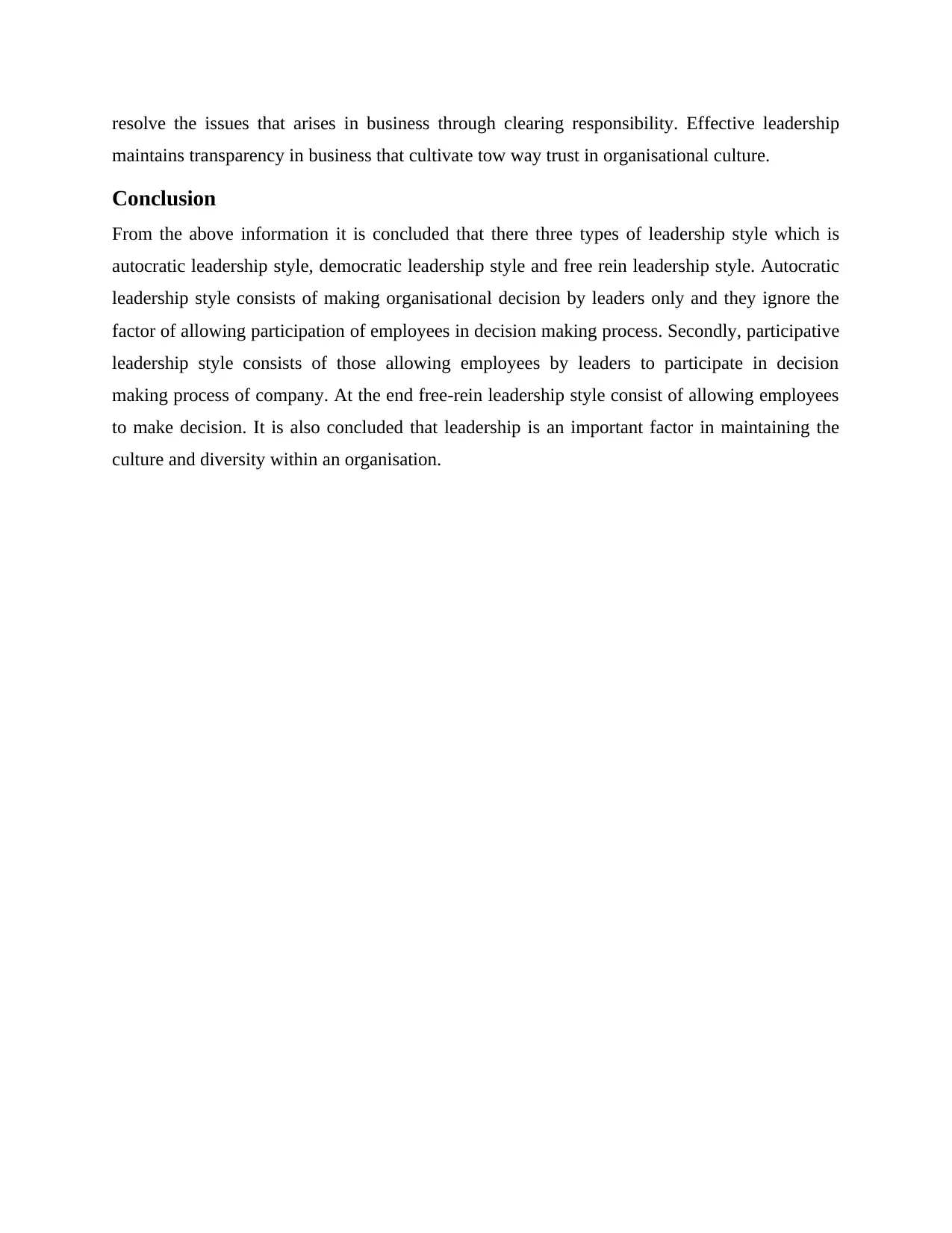
resolve the issues that arises in business through clearing responsibility. Effective leadership
maintains transparency in business that cultivate tow way trust in organisational culture.
Conclusion
From the above information it is concluded that there three types of leadership style which is
autocratic leadership style, democratic leadership style and free rein leadership style. Autocratic
leadership style consists of making organisational decision by leaders only and they ignore the
factor of allowing participation of employees in decision making process. Secondly, participative
leadership style consists of those allowing employees by leaders to participate in decision
making process of company. At the end free-rein leadership style consist of allowing employees
to make decision. It is also concluded that leadership is an important factor in maintaining the
culture and diversity within an organisation.
maintains transparency in business that cultivate tow way trust in organisational culture.
Conclusion
From the above information it is concluded that there three types of leadership style which is
autocratic leadership style, democratic leadership style and free rein leadership style. Autocratic
leadership style consists of making organisational decision by leaders only and they ignore the
factor of allowing participation of employees in decision making process. Secondly, participative
leadership style consists of those allowing employees by leaders to participate in decision
making process of company. At the end free-rein leadership style consist of allowing employees
to make decision. It is also concluded that leadership is an important factor in maintaining the
culture and diversity within an organisation.
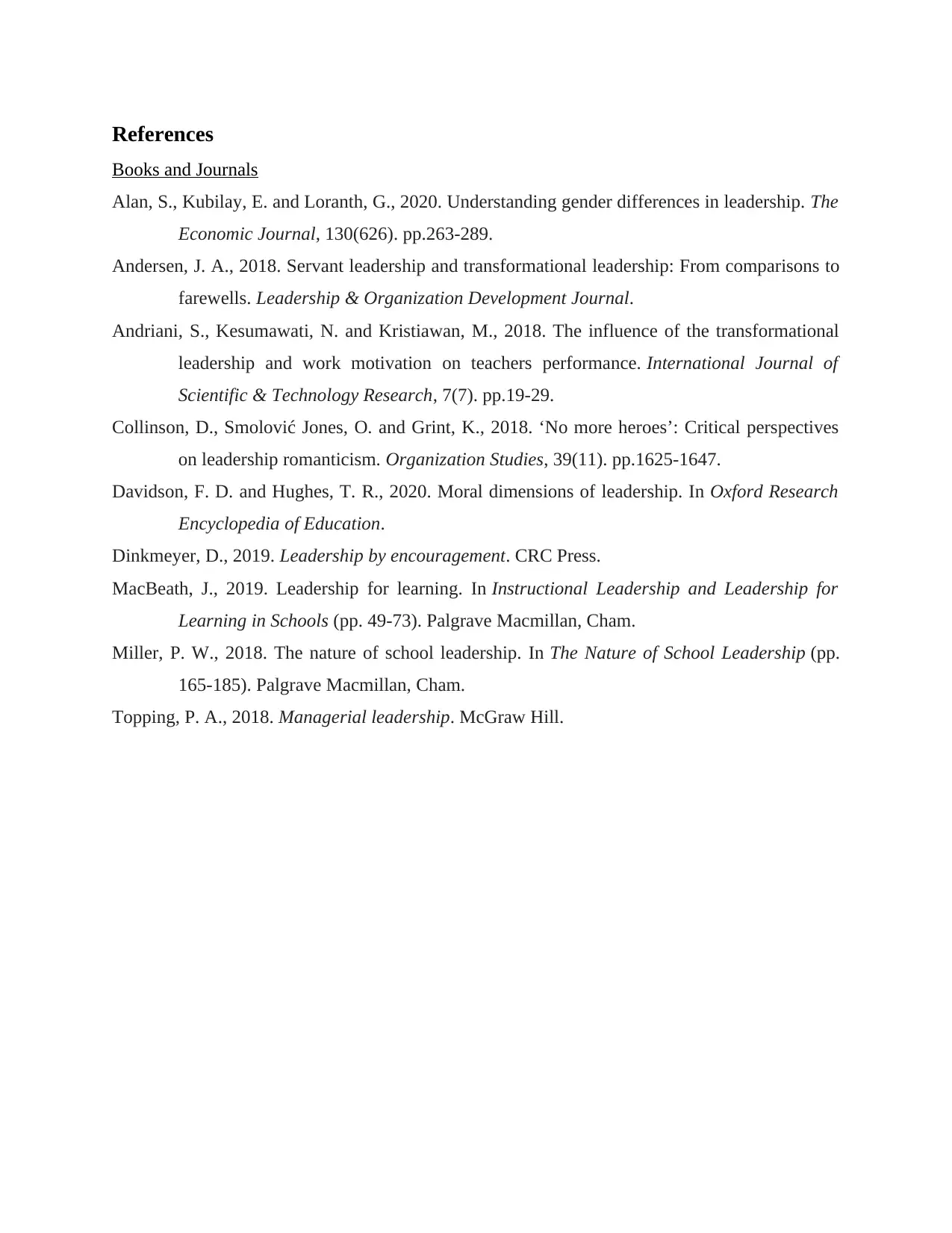
References
Books and Journals
Alan, S., Kubilay, E. and Loranth, G., 2020. Understanding gender differences in leadership. The
Economic Journal, 130(626). pp.263-289.
Andersen, J. A., 2018. Servant leadership and transformational leadership: From comparisons to
farewells. Leadership & Organization Development Journal.
Andriani, S., Kesumawati, N. and Kristiawan, M., 2018. The influence of the transformational
leadership and work motivation on teachers performance. International Journal of
Scientific & Technology Research, 7(7). pp.19-29.
Collinson, D., Smolović Jones, O. and Grint, K., 2018. ‘No more heroes’: Critical perspectives
on leadership romanticism. Organization Studies, 39(11). pp.1625-1647.
Davidson, F. D. and Hughes, T. R., 2020. Moral dimensions of leadership. In Oxford Research
Encyclopedia of Education.
Dinkmeyer, D., 2019. Leadership by encouragement. CRC Press.
MacBeath, J., 2019. Leadership for learning. In Instructional Leadership and Leadership for
Learning in Schools (pp. 49-73). Palgrave Macmillan, Cham.
Miller, P. W., 2018. The nature of school leadership. In The Nature of School Leadership (pp.
165-185). Palgrave Macmillan, Cham.
Topping, P. A., 2018. Managerial leadership. McGraw Hill.
Books and Journals
Alan, S., Kubilay, E. and Loranth, G., 2020. Understanding gender differences in leadership. The
Economic Journal, 130(626). pp.263-289.
Andersen, J. A., 2018. Servant leadership and transformational leadership: From comparisons to
farewells. Leadership & Organization Development Journal.
Andriani, S., Kesumawati, N. and Kristiawan, M., 2018. The influence of the transformational
leadership and work motivation on teachers performance. International Journal of
Scientific & Technology Research, 7(7). pp.19-29.
Collinson, D., Smolović Jones, O. and Grint, K., 2018. ‘No more heroes’: Critical perspectives
on leadership romanticism. Organization Studies, 39(11). pp.1625-1647.
Davidson, F. D. and Hughes, T. R., 2020. Moral dimensions of leadership. In Oxford Research
Encyclopedia of Education.
Dinkmeyer, D., 2019. Leadership by encouragement. CRC Press.
MacBeath, J., 2019. Leadership for learning. In Instructional Leadership and Leadership for
Learning in Schools (pp. 49-73). Palgrave Macmillan, Cham.
Miller, P. W., 2018. The nature of school leadership. In The Nature of School Leadership (pp.
165-185). Palgrave Macmillan, Cham.
Topping, P. A., 2018. Managerial leadership. McGraw Hill.
⊘ This is a preview!⊘
Do you want full access?
Subscribe today to unlock all pages.

Trusted by 1+ million students worldwide
1 out of 9
Related Documents
Your All-in-One AI-Powered Toolkit for Academic Success.
+13062052269
info@desklib.com
Available 24*7 on WhatsApp / Email
![[object Object]](/_next/static/media/star-bottom.7253800d.svg)
Unlock your academic potential
Copyright © 2020–2025 A2Z Services. All Rights Reserved. Developed and managed by ZUCOL.




